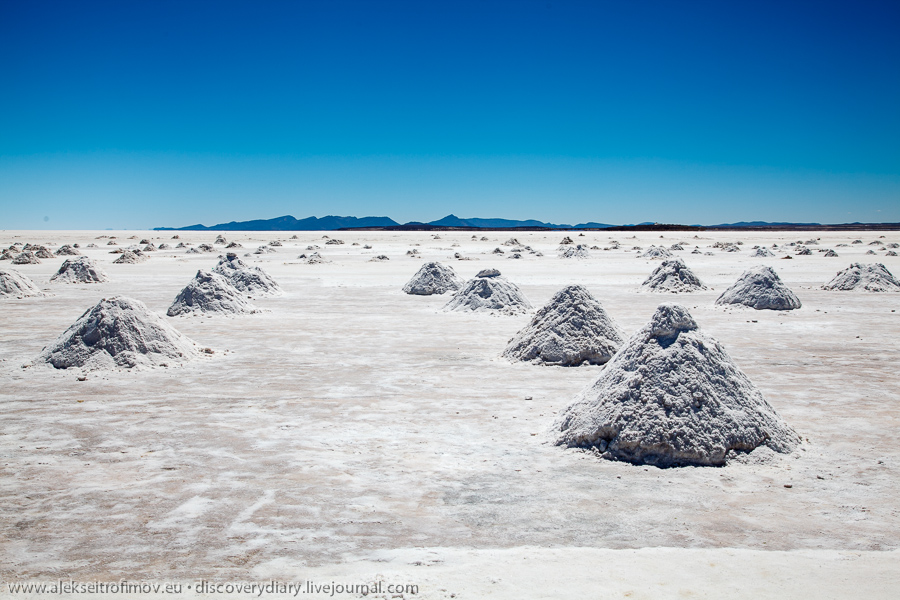Salar de Uyuni is one of Bolivia’s greatest attractions. A strange formation, 10000 square metre large, is found in the South West of the country, in the corner formed by the borders of Chile and Argentina. The Salar is an ancient salty lake which dried up quite recently in geological terms – about 50000 years ago. The layer of salt several metres thick covers the ground in every direction you look, and the salt cover is so sizeable and so exceptionally flat that it is used by all the satellites to calibrate their measuring devices. The Salar is located on the Altiplano, altitude 3656 metres. The Altiplano itself is a rugged mix of mountains and valleys, on the contrary Salar is a perfect plane that can be easily crossed by car in any point.
The Salar tours normally depart from the mountain outpost of Uyuni. You can venture from Uyuni to the Salar within one day, but the majority of tourists choose the three-day tours, and this is what I did as well. This tour spends the first day on the Salar itself and then continues further South towards the Chilean border. A Toyota Landcruiser 4×4 is usually shared between 5-6 tourists and a driver. I read lots of reviews and many of them warned about all kinds of risks caused mainly by the human factor – that the drivers tend to drink heavy alcohol when driving, speed unnecessarily, that the cars tend to break down and sometimes crash spectacularly etc. Already having experienced Bolivia’s safety standards, I knew that these stories were to be taken seriously. But even in Uyuni the choice of a tour company is very much a gamble – all 70 companies offer similar tours for similar prices, all have positive and negative reviews on the web, all say that safety would be ideal, and all may actually put you in a car of a different company. Travelling alone, I didn’t consider taking an individual tour, and in fact the idea of spending three days bonding with some unknown travel mates sounded kind of fascinating. Lonely Planet made a solemn promise that this bonding would be an unforgettable experience.
And all the promises came true. The Salar’s nature is absolutely spectacular. Our car broke down in regular intervals, its exhaust tube fell off entirely, and the driver spent half the trip under the track. At least he did not drink, which we carefully monitored. Finally the group I found myself in seemed tailor-made for me. We were six. All solo travellers. Five guys and a lady. 2 Brits, 1 Israeli living in Canada, 1 Venezuelan living in Barcelona, 1 Argentine and 1 Estonian Russian living in Brussels.
The tour travels considerable amount of time at the altitude above 4000. The nights are spent in pretty basic conditions: the first night in a salt hotel, the second at the altitude of 4200 in a army barack-type dorm of six. No heating in either place, and we were promised minus 20 degrees on the second night. In truth the sleeping bags saved from the cold. But overall, the altitude, the cold, the strange food, the endless road, the sun, all of this stresses the body and mind to no end.
But sharing this physical and mental challenge certainly helps you to get to know each other. During these three days we managed to discuss everything under the sun. The Israeli guy was particularly interested in the expressive opportunities of the Spanish language. The Spanish teacher among us obliged. And so for most of the trip our poor driver Zoher was glancing back in amazement why we are discussing various human activities in such graphic detail. I was more interested, as is my way, in people’s experiences, of life and of love, and so heard an account of passion and hatred in Cairo, an advanced course in crazy Argentinean politics, an insight into Israeli army’s recruitment and training and many other amazing stories. The whole trip was orchestrated like a theatre play. The key revelations on people’s identities only came in gradually, with appropriate suspense.
The first look at the Salar:

Continue reading Salar de Uyuni →